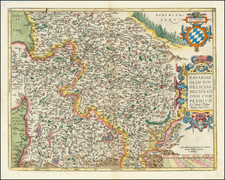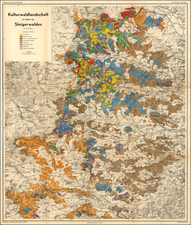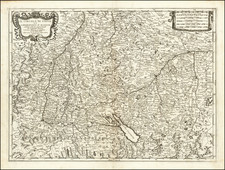Second state of Jansson's rare map of Nova Franconia, engraved by Abraham Goos and first published in 1626.
The map is a striking carte a figures map of the Franconia region in Germany, which depicts the region in great detail, including the cities, rivers, forests, and mountains. The map is surrounded by a decorative border that includes costumed figures on each side. The figures are depicted in traditional clothing of the region
At the top and bottom of the map, there are panoramic city views of some of the major cities in the region, including Nuremberg, Wurzburg, Bamburg, Fulda, Rothenburg ob der Tauber, and Budingen. These views are beautifully detailed, showing the buildings, and landmarks of each city. The views are a testament to the artistic skill of the engraver and provide a glimpse into what these cities may have looked like in the early 17th century. Frankfurt appears at the far west.
The Franconia region in the early 17th century was part of the Holy Roman Empire.
In summary, "Nova Franconiae Descriptio" is a beautifully crafted map that provides a detailed and accurate depiction of the Franconia region in the early 17th century. The costumed figures and city views add a touch of artistry to the map, while the political context gives it historical significance.
Jan Janssonius (also known as Johann or Jan Jansson or Janszoon) (1588-1664) was a renowned geographer and publisher of the seventeenth century, when the Dutch dominated map publishing in Europe. Born in Arnhem, Jan was first exposed to the trade via his father, who was also a bookseller and publisher. In 1612, Jan married the daughter of Jodocus Hondius, who was also a prominent mapmaker and seller. Jonssonius’ first maps date from 1616.
In the 1630s, Janssonius worked with his brother-in-law, Henricus Hondius. Their most successful venture was to reissue the Mercator-Hondius atlas. Jodocus Hondius had acquired the plates to the Mercator atlas, first published in 1595, and added 36 additional maps. After Hondius died in 1612, Henricus took over publication; Janssonius joined the venture in 1633. Eventually, the atlas was renamed the Atlas Novus and then the Atlas Major, by which time it had expanded to eleven volumes. Janssonius is also well known for his volume of English county maps, published in 1646.
Janssonius died in Amsterdam in 1664. His son-in-law, Johannes van Waesbergen, took over his business. Eventually, many of Janssonius’ plates were sold to Gerard Valck and Pieter Schenk, who added their names and continued to reissue the maps.









![Heidelberga [and] Spira [and] Wormatia](https://storage.googleapis.com/raremaps/img/small/98992.jpg)




![[Augsburg] Augusta iuxta figuram quam his ce temporibus habet delineata](https://storage.googleapis.com/raremaps/img/small/89285.jpg)